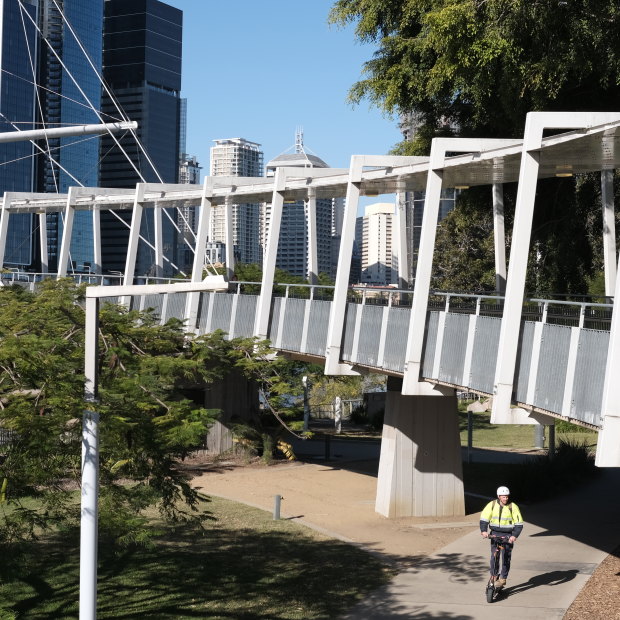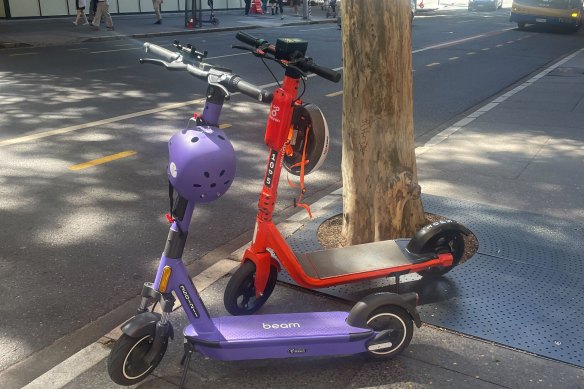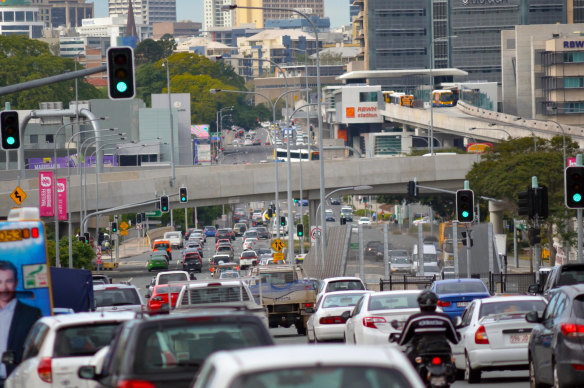This was published 1 year ago
Most Brisbane traffic isn’t for work, yet everything leads to the city
By Tony Moore

Many of Brisbane’s inner- and even outer-city bike and e-scooter paths are also shared with pedestrians.Credit: Matt Dennien
Brisbane’s transport network is largely designed to get people to the CBD, despite 30 per cent of trips being less than six kilometres in length and often more local than city-bound.
Data shows more than two-thirds of all transport trips are for the school run, to go shopping, or meet friends, while only between 37 per cent (in peak hours) and 25 per cent (all day) are to and from work.
Many of the 6.5 million daily transport trips in Greater Brisbane are in residents’ local areas, with trips in and out of the CBD declining.
“In fact, there are more people travelling around the city, or locally, than in to the city,” said researcher and transport planner David Hayward.
“I think the investment is disproportionate to catering for people who travel to the city, rather than to the rest of the city.”

Beam and Neuron have been Brisbane’s primary providers of e-scooters since 2021.Credit: Courtney Kruk
One solution might be off-road, through the provision of better paths to allow pedestrians, cyclists and scooter riders to literally avoid the traffic, particularly in suburban areas. That would reduce congestion and travel time for other commuters, such as those undertaking work trips that are longer on average.
How Brisbane and Melbourne commuters differ
Brisbane
- Inward - 26.4 per cent
- Short - 30.1 per cent
- Contraflow - 9.3 per cent
- Circumferential - 34.2 per cent
Melbourne
- Inward - 58 per cent
- Short - 9 per cent
- Contraflow - 9 per cent
- Circumferential - 24 per cent
Source: How the four types of commuters are distributed throughout Greater Brisbane, a paper presented at the Australasian Transport Research Forum in December 2023
Hayward and his colleagues revealed Brisbane’s transport dilemma in a recent presentation to the Australasian Transport Research Forum.
The research splits Brisbane commuters into four categories – inward, short, contraflow and circumferential – in an effort to determine infrastructure needs.
Inward commutes are to the CBD, short trips are less than six kilometres in the same local government area, contraflow trips are trips to a neighbouring council area, and circumferential trips are around the city.
“Many of the ‘short’ work trips in Greater Brisbane would be less than 6km, which makes them attractive ‘candidate’ trips for active transport; walking or cycling.”
Transport planner David Hayward et al, December 2023
“It’s a real blind spot in our industry in how we plan our major pieces of infrastructure,” Hayward said.
“It is biased towards infrastructure running towards the inner-city, compared to suburbia.”
Hayward said the Brisbane research showed a strong cross-city travel from Stafford, west of Chermside across Virginia, through the industrial precincts and out towards the Brisbane Airport.
“Yet there is no direct public transport service that covers that line,” he said.
“So the advantage of driving a car in terms of cost and travel time is enormous. You wouldn’t bother doing anything else because you have to catch a bus or train back to the city and then back out to the airport.”
Latest figures from the Department of Transport and Main Roads shows an additional 417,727 vehicles registered since June 2005, taking the number of vehicles on the road to 1.23 million.

There are now 1.24 million vehicles on Queensland roads, up by 414,000 in the past decade. Credit: Alamy
More have been registered since 2013-14 (1,004,926) than in the decade before (812,354), which means our love affair with our car is stronger than ever.
While the public transport network is being bolstered, through Cross River Rail and Metro buses, Hayward suggested more be done to facilitate walking, riding, and scooting in the suburbs.
“You would start from the main suburban centres at Chermside, Indooroopilly, Carindale and Mt Gravatt and start building bikeways and public transport where people are living in to those centres,” he said.
“The demand and trends are here. It is just government is blind to them.”
A spokesman for the Queensland Department of Transport and Main Roads said it already worked with Translink and Brisbane City Council to provide extensive bus services to major shopping centres.
He said bikeways were determined by councils and representative cycling groups, based on demand.
Get the inside word on the news, sport, food, people and places Brisbane is talking about. Sign up for our City Talk newsletter here.